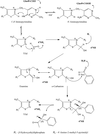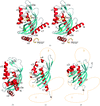issue contents
December 2007 issue

Cover illustration: Superposition of different binding modes in complex structures of ![[beta]](/logos/entities/beta_rmgif.gif) -ketoacyl-ACP-syntase (KAS I) with the ligands thiolactomycin (cyan), cerulenin (gold) and aminothiazole (green) (p. 1208).
-ketoacyl-ACP-syntase (KAS I) with the ligands thiolactomycin (cyan), cerulenin (gold) and aminothiazole (green) (p. 1208).
research papers
The first crystal structures of human dCK in complex with products are reported.
Open  access
access
 access
accessβ-Ketoacyl-ACP synthase is a key target for the treatment of infectious diseases. A structure-based biophysical screening approach identified for the first time a synthetic small molecule, 2-phenylamino-4-methyl-5-acetylthiazole, that binds to the active site of the enzyme. Implications for the use of this information in drug discovery are discussed.
Crystal structures of recombinant branched-chain keto acid decarboxylase (KdcA) from L. lactis were determined as a binary complex with the cofactor thiamin diphosphate and as a complex with an analogue of a reaction intermediate to 1.6 and 1.8 Å resolution, respectively.
Familial oncocytic thyroid carcinoma is associated with a missense mutation, P308Q, in the C-terminal domain of Tim44. Here, the crystal structure of the human Tim44 C-terminal domain in complex with pentaethylene glycol at 1.9 Å resolution is reported.
PDB reference: Tim44 C-terminal domain, 2cw9, r2cw9sf
A simple three-parameter ADP model for macromolecules has been devised and examined with respect to its potential use in macromolecular crystallography.
Two structures of regulatory chain mutants Asp19Ar and His20Ar of E. coli aspartate transcabomylase are presented. Small structural changes illustrate small, but significant, changes in kinetic behavior of both mutant enzymes and suggest that His20 and Asp19 participate in heterotropic regulatory pathways.
The crystal structure of triclinic hen egg-white lysozyme refined at 0.65 Å resolution is presented.
PDB reference: triclinic lysozyme, 2vb1, r2vb1sf
short communications
A 2.1 Å resolution crystal structure of the B. subtilis organic hydroperoxide-resistance protein B reveals details of the stereochemistry of the disulfide bonds in the transient oxidized form of the enzyme.
PDB reference: organic hydroperoxide-resistance protein B, 2bjo, r2bjosf
letters to the editor
Free 

Free 



 journal menu
journal menu


























